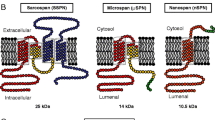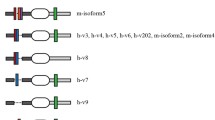Abstract
The sarcoplasmic/endoplasmic reticulum calcium ATPase 1 (SERCA1) has two muscle specific splice isoforms; SERCA1a in fast-type adult and SERCA1b in neonatal and regenerating skeletal muscles. At the protein level the only difference between these two isoforms is that SERCA1a has C-terminal glycine while SERCA1b has an octapeptide tail instead. This makes the generation of a SERCA1a specific antibody not feasible. The switch between the two isoforms is a hallmark of differentiation so we describe here a method based on the signal ratios of the SERCA1b specific and pan SERCA1 antibodies to estimate the SERCA1b/SERCA1a dominance on immunoblot of human muscles. Using this method we showed that unlike in mouse and rat, SERCA1b was only expressed in pre-matured infant leg and arm muscles; it was replaced by SERCA1a in more matured neonatal muscles and was completely absent in human foetal and neonatal diaphragms. Interestingly, only SERCA1a and no SERCA1b were detected in muscles of 7–12 years old boys with Duchenne, a degenerative-regenerative muscular dystrophy. However, in adult patients with myotonic dystrophy type 2 (DM2), the SERCA1b dominated over SERCA1a. Thus the human SERCA1b has a different expression pattern from that of rodents and it is associated with DM2.




Similar content being viewed by others
References
Babu GJ, Bhupathy P, Carnes CA, Billman GE, Periasamy M (2007) Differential expression of sarcolipin protein during muscle development and cardiac pathophysiology. J Mol Cell Cardiol 43:215–222
Brandl CJ, Green NM, Korczak B, MacLennan DH (1986) Two Ca2+ ATPase genes: homologies and mechanistic implications of deduced amino acid sequences. Cell 44:597–607
Brandl CJ, deLeon S, Martin DR, MacLennan DH (1987) Adult forms of the Ca2+ATPase of sarcoplasmic reticulum. Expression in developing skeletal muscle. J Biol Chem 262:3768–3774
Chami M, Gozuacik D, Lagorce D, Brini M, Falson P, Peaucellier G, Pinton P, Lecoeur H, Gougeon ML, le Maire M, Rizzuto R, Bréchot C, Paterlini-Bréchot P (2001) SERCA1 truncated proteins unable to pump calcium reduce the endoplasmic reticulum calcium concentration and induce apoptosis. J Cell Biol 153:1301–1314
Colling-Saltin AS (1978) Enzyme histochemistry on skeletal muscle of the human foetus. J Neurol Sci 39:169–185
Fajardo VA, Bombardier E, Vigna C, Devji T, Bloemberg D, Gamu D, Gramolini AO, Quadrilatero J, Tupling AR (2013) Co-expression of SERCA isoforms, phospholamban and sarcolipin in human muscles. PLoS One 8(12):e84304
Gayan-Ramirez G, Vanzeir L, Wuytack F, Decramer M (2000) Corticosteroids decrease mRNA levels of SERCA pumps, whereas they increase sarcolipin mRNA in the rat diaphragm. J Physiol 524:387–397
Guglielmi V et al (2013a) SERCA1 protein expression in muscle of patients with Brody disease and Brody syndrome and in cultured human muscle fibers. Mol Genet Metab 110:162–169
Guglielmi V, Voermans N, Gualandi F, Van Engelen BG, Fertini A, Tomelleri G, Vattemi G (2013b) Fourty-Four Years of Brody disease: it is time to review. J Genet Syndr Gene Ther 4:181
Kimura T, Nakamori M, Lueck JD, Pouliquin P, Aoike F, Fujimura H, Dirksen RT, Takahashi MP, Dulhunty AF, Sakoda S (2005) Altered mRNA splicing of the skeletal muscle ryanodine receptor and sarcoplasmic/endoplasmic reticulum Ca2+-ATPase in myotonic dystrophy type 1. Hum Mol Genet 14:2189–2200
Kiviluoto S, Decuypere J-P, De Smedt H, Missiaen L, Parys J, Bultynck G (2011) STIM1 as a key regulator for Ca2+ homeostasis in skeletal-muscle development and function. Skelet Muscle 1:16
Kósa M, Zádor E (2013) Transfection efficiency along the regenerating soleus muscle of the rat. Mol Biotechnol 54:220–227
Lee KJ, Hyun C, Woo JS, Park CS, Kim do H, Lee EH (2014) Stromal interaction molecule 1 (STIM1) regulates sarcoplasmic/endoplasmic reticulum Ca2+-ATPase 1a (SERCA1a) in skeletal muscle. Pflugers Arch 466:987–1001
MacLennan DH, Brandl CJ, Korczak B, Green NM (1985) Amino-acid sequence of a Ca2+ + Mg2+ -dependent ATPase from rabbit muscle sarcoplasmic reticulum, deduced from its complementary DNA sequence. Nature 316:696–700
Maruyama K, MacLennan D (1988) Mutation of aspartic acid-351, lysine-352, and lysine-515 alters the Ca2+ transport activity of the Ca2+-ATPase expressed in COS-1 cells. P Natl Acad Sci USA 85:3314–3318
Orliaguet G, Riou B, Leguen M (2004) Postnatal maturation of the diaphragm muscle: ultrastructural and functional aspects. Ann Fr Anesth Reanim 23:482–494
Pan Y, Zvaritch E, Tupling AR, Rice WJ, de Leon S, Rudnicki M, McKerlie C, Banwell BL, MacLennan DH (2003) Targeted disruption of the ATP2A1 gene encoding the sarco(endo)plasmic reticulum Ca2+-ATPase isoform 1 (SERCA1) impairs diaphragm function and is lethal in neonatal mice. J Biol Chem 278:13367–13375
Periasamy M, Kalyanasundaram A (2007) SERCA pump isoforms: their role in calcium transport and disease. Muscle Nerve 35:430–442
Salvatori S, Furlan S, Fanin M, Picard A, Pastorello E, Romeo V, Trevisan CP, Angelini C (2009) Comparative transcriptional and biochemical studies in muscle of myotonic dystrophies (DM1 and DM2). Neurol Sci 30:185–192
Santoro M, Piacentini R, Masciullo M, Bianchi ML, Modoni A, Podda MV, Ricci E, Silvestri G, Grassi C (2014) Alternative splicing alterations of Ca2+ handling genes are associated with Ca2+ signal dysregulation in DM1 and DM2 myotubes. Neuropath Appl Neurobiol 40:464–476
Schiaffino S, Reggiani C (2011) Fiber types in mammalian skeletal muscles. Physiol Rev 91:1447–1531
Schneider JS, Shanmugam M, Gonzalez JP, Lopez H, Gordan R, Fraidenraich D, Babu GJ (2013) Increased sarcolipin expression and decreased sarco(endo)plasmic reticulum Ca2+ uptake in skeletal muscles of mouse models of Duchenne muscular dystrophy. J Muscle Res Cell Motil 34:349–356
Schöneich C, Viner RI, Ferrington DA, Bigelow DJ (1999) Age-related chemical modification of skeletal muscle sarcoplasmic reticulum Ca-ATPase of the rat. Mech Ageing Dev 107:221–231
Seth M, Li T, Graham V, Burch J, Finch E, Stiber JA, Rosenberg PB (2012) Dynamic regulation of sarcoplasmic reticulum Ca(2+) stores by stromal interaction molecule 1 and sarcolipin during muscle differentiation. Dev Dynam 241:639–647
Stiber J, Hawkins A, Zhang Z-S, Wang S, Burch J, Graham V, Ward CC, Seth M, Finch E, Malouf N, Williams RS, JP Eu, Rosenberg P (2008) STIM1 signalling controls store-operated calcium entry required for development and contractile function in skeletal muscle. Nature Cell Biol 10:688–697
Vangheluwe P, Schuermans M, Zádor E, Waelkens E, Raeymaekers L, Wuytack F (2005) Sarcolipin and phospholamban mRNA and protein expression in cardiac and skeletal muscle of different species. Biochem J 389:151–159
Vihola A, Bassez G, Meola G, Zhang S, Haapasalo H, Paetau A, Mancinelli E, Rouche A, Hogrel JY, Laforêt P, Maisonobe T, Pellissier JF, Krahe R, Eymard B, Udd B (2003) Histopathological differences of myotonic dystrophy type 1 (DM1) and PROMM/DM2. Neurology 60:1854–1857
Vihola A, Sirito M, Bachinski LL, Raheem O, Screen M, Suominen T, Krahe R, Udd B (2013) Altered expression and splicing of Ca(2+) metabolism genes in myotonic dystrophies DM1 and DM2. Neuropathol Appl Neurobiol 39:390–405
Zádor E, Mendler L, Ver Heyen M, Dux L, Wuytack F (1996) Changes in mRNA levels of the sarcoplasmic/endoplasmic-reticulum Ca(2 +)-ATPase isoforms in the rat soleus muscle regenerating from notexin-induced necrosis. Biochem J 320(Pt 1):107–113
Zádor E, Szakonyi G, Rácz G, Mendler L, Ver Heyen M, Lebacq J, Dux L, Wuytack F (1998) Expression of the sarco/endoplasmic reticulum Ca(2 +)-transport ATPase protein isoforms during regeneration from notexin-induced necrosis of rat soleus muscle. Acta Histochem 100:355–369
Zádor E, Dux L, Wuytack F (1999) Prolonged passive stretch of rat soleus muscle provokes an increase in the mRNA levels of the muscle regulatory factors distributed along the entire length of the fibers. J Muscle Res Cell M 20:395–402
Zádor E, Vangheluwe P, Wuytack F (2007) The expression of the neonatal sarcoplasmic reticulum Ca2 + pump (SERCA1b) hints to a role in muscle growth and development. Cell Calcium 41:379–388
Zádor E, Owsianik G, Wuytack F (2011) Silencing SERCA1b in a few fibers stimulates growth in the entire regenerating soleus muscle. Histochem Cell Biol 135:11–20
Zhang Y, Fujii J, Phillips MS, Chen HS, Karpati G, Yee WC, Schrank B, Cornblath DR, Boylan KB, MacLennan DH (1995) Characterization of cDNA and genomic DNA encoding SERCA1, the Ca(2+)-ATPase of human fast-twitch skeletal muscle sarcoplasmic reticulum, and its elimination as a candidate gene for Brody disease. Genomics 30:415–424
Zhao X, Moloughney JG, Zhang S, Komazaki S, Weisleder N (2012) Orai1 mediates exacerbated Ca(2+) entry in dystrophic skeletal muscle. PLoS ONE 7:e49862
Zubrzycka-Gaarn E, MacDonald G, Phillips L, Jorgensen A, MacLennan D (1984) Monoclonal antibodies to the Ca2+ + Mg2+-dependent ATPase of sarcoplasmic reticulum identify polymorphic forms of the enzyme and indicate the presence in the enzyme of a classical high-affinity Ca2+ binding site. J Bioenerg Biomembr 16:441–464
Acknowledgments
The authors would like to thank Dr. László Kaiser, Dr. Zoltán Varga, Dr. Lajos Pintér and Dr. Lajos Haracska for help. This project was supported by the TÁMOP-4.2.2/B-10/1-2010-0012; Magdolna Kósa was supported by the European Union and the State of Hungary, co-financed by the European Social Fund in the framework of TÁMOP 4.2.4. A/2-11-1-2012-0001 ‘National Excellence Program’.
Author information
Authors and Affiliations
Corresponding author
Rights and permissions
About this article
Cite this article
Kósa, M., Brinyiczki, K., van Damme, P. et al. The neonatal sarcoplasmic reticulum Ca2+-ATPase gives a clue to development and pathology in human muscles. J Muscle Res Cell Motil 36, 195–203 (2015). https://doi.org/10.1007/s10974-014-9403-z
Received:
Accepted:
Published:
Issue Date:
DOI: https://doi.org/10.1007/s10974-014-9403-z




